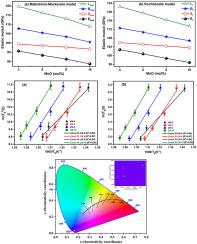二氧化锰掺杂硼硅酸盐玻璃的发光、力学和非等温结晶动力学
IF 3.5
3区 化学
Q2 CHEMISTRY, INORGANIC & NUCLEAR
引用次数: 0
摘要
本研究探讨了MnO掺杂对熔融淬火法制备30SiO2-50B2O3 -(20-x)Li2O-xMnO(其中x = 4、6、8和10 mol%)玻璃的力学、非等温结晶动力学和发光性能的影响。采用Makishima-Mackenzie (MMR)模型和Rocherulle (RM)模型对制备的玻璃样品的力学性能进行了研究。FTIR光谱证实了制备的玻璃样品中存在不同结构单元的硼酸盐和硅酸盐。采用Kissinger和Augis-Bennett模型研究了所制备玻璃的活化能(Eg, Er和Ec)。MnO对Li2O的取代导致了玻璃网络的弱化,因此,MnO掺杂量最高(lm - 10,10 mol%)的玻璃具有最低的网络刚性。MnO (lm - 4,4 mol%)掺杂最少的玻璃具有最高的结晶活化能(Eg)。当MnO (LM-10, 10 mol%)掺杂量最大时,玻璃的结晶活化能(Eg)最低。脆性指数随MnO掺量和升温速率的增加呈下降趋势,热稳定性随MnO掺量的增加呈上升趋势。相关色温值介于1692和1712 K之间,证实了掺mno的硼硅酸盐玻璃主要在蓝粉色区域发光,突出了它们在光子学应用中的潜在用途。本文章由计算机程序翻译,如有差异,请以英文原文为准。

Luminescence, mechanical and non-isothermal crystallization kinetics properties of MnO-doped borosilicate glasses for photonics applications
This study explores the MnO doping effects on mechanical, non-isothermal crystallization kinetics and luminescence properties of 30SiO2–50B2O3-(20-x)Li2O-xMnO (where, x = 4, 6, 8, and 10 mol%) glasses produced by melting and quenching method. Makishima-Mackenzie (MMR) and Rocherulle (RM) models are used to study the mechanical properties of the prepared glass samples. The FTIR spectra confirm the presence of different structural units of borate and silicate in the prepared glass samples. The Kissinger and Augis-Bennett models are used to study the activation energies (Eg, Er, and Ec) of the prepared glasses. The substitution of Li2O with MnO is responsible for weakening the glass network, and, consequently, glass with the highest doping of MnO (LM-10, 10 mol%) exhibits lowest network rigidity. Glass with the lowest doping of MnO (LM-4, 4 mol%) exhibits the highest activation energy (Eg) for crystallization. While glass with the highest doping of MnO (LM-10, 10 mol%) exhibits the lowest activation energy (Eg) of crystallization. The fragility index shows a decreasing trend with MnO doping and heating rates, while thermal stability shows an increasing trend with increasing MnO doping. The value of correlated colour temperature lies between 1692 and 1712 K and confirms that the MnO-doped borosilicate glasses predominantly emit in the bluish-pink region, highlighting their potential utility in photonics applications.
求助全文
通过发布文献求助,成功后即可免费获取论文全文。
去求助
来源期刊

Journal of Solid State Chemistry
化学-无机化学与核化学
CiteScore
6.00
自引率
9.10%
发文量
848
审稿时长
25 days
期刊介绍:
Covering major developments in the field of solid state chemistry and related areas such as ceramics and amorphous materials, the Journal of Solid State Chemistry features studies of chemical, structural, thermodynamic, electronic, magnetic, and optical properties and processes in solids.
 求助内容:
求助内容: 应助结果提醒方式:
应助结果提醒方式:


